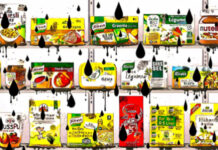FAO(Food Agriculture Organization) and WHO(World Health Organization). discussed with the African Union and theWorld Trade Organization (WTO) the future of global food security. Ad in Addis Ababa, Ethiopia, on 12-13.2.19.
‘The future of food safety.
‘, 2019
‘The Future of Food Safety’ is the ratio presented by FAO, WHO, WTO and African Union at the Addis Ababa Conference. First and foremost, a basic human right, access to safe and nutritious food as well as clean water, is reaffirmed. ‘Today’s global challenges are transforming the way we produce, market, consume, and think about food’. However, the universal right to food remains a utopia-beyond the ‘solemn’ verbal commitments of various governments-because of malnutrition
and malnutrition
, as well as food safety hazards.
‘Every year all over the world more than 420,000 people die and about 600 million people-almost one in ten-get sick after eating contaminated food. In fact, food hazards are known to cause more than 200 acute and chronic diseases, from digestive tract infections to cancer‘, the report indicates. (1) And added to human suffering is economic injury. ‘Contaminated foods hinder socio-economic development, overburden health systems and undermine economic growth, trade and tourism.’ (2)
‘The future of food safety
‘, 5 key messages
Five key messages are affirmed in the international report ‘The Future of Food Safety:
– Food security is an integral part of theSustainable Developers Goals (SDGs),
– unsafe food has a huge and unacceptable impact on human health and the economy,
– agriculture
is under pressure and it is imperative to adopt sustainable agricultural practices
. To reduce the environmental impact of production, mitigate climate change
, promote economic growth andsocial equity.
,
– from primary agricultural production to consumption, food safety is a shared responsibility that requires the collaboration of all actors in the supply chain, based on international standards and harmonized rules,
– a healthy diet Requires safe and nutritious food. Foods at risk, such as those that are nutritionally imbalanced
, put children’s development at risk and expose populations to noncommunicable diseases (
Non-Communicable Diseases
, NCDs). A vicious cycle that needs to be broken.
Universal right to food and ‘
food security
‘
The so-called ‘f
ood security
‘ – that is, the security of the food supply – is seriously threatened by climate change
, environmental degradation, water scarcity and soil depletion, and loss of biodiversity. This needs to be reversed.
‘
It is essential
adopt sustainable procedures to grow, produce and consume safe and healthy food, while preserving our planet’s resources
‘.
The next Forum International Food Safety and Trade, in Geneva on 4/23-24/19, will be devoted to food safety in international trade. Focus on challenges and opportunities related to new technologies
e
knowledge transfer
. As well as on the harmonization of rules to guard food safety and controls.
Food security, how to protect the planet’s consumers
Chemical safety and microbiological contamination of foods continue to pose serious public health risks. The inability to prevent and control such risks, particularly in low- to middle-income countries, severely hampers their economies and undermines the security of trade in an increasingly interconnected global supply chain.
‘
Today, protecting health
consumers ranges from inspecting for food additives and pesticide residues to preventing chemical and microbiological contamination or evaluating the safety of modern, sometimes controversial practices such as genetic modification of food or the use of growth-promoting antimicrobials in animal production. Times have changed but the goal of protecting consumers remains the same.’
For example, mycotoxins can cause toxicity in corn, coffee, cocoa, severely impacting the health of the most exposed populations. Then there is the major issue of the safety of food of animal origin, which postulates the adoption of proper hygienic practices at all stages of feeding, raising and slaughtering. Impacting, among other things, the global health emergency of antibiotic resistance.
Food safety, antibiotic resistance.
Antibiotic resistance is one of the most pressing public health emergencies globally. Antibiotics lose efficacy and it becomes difficult-when not impossible-to treat diseases such as pneumonia, tuberculosis, salmonellosis
and other infections, even the most trivial. With longer hospitalization times, increased health care costs and mortality. ‘
Every year, about 700,000 people die worldwide from antimicrobial-resistant infections
‘. In low- and middle-income countries and beyond, recalls the World Health Organization.
The European Centre for Disease Prevention and Control (ECDC), in its study published in ‘The Lancet‘ on 5.11.18, estimates that infections with antibiotic-resistant bacteria caused 33,000 deaths in 2015 in Europe. Among other things, Italy and Greece have a marked prevalence of infections with antibiotic-resistant bacteria, accounting for 21.3 percent of the European area total (172 out of 875,000 cases). (3) The OECD (Organization for Economic Co-operation and Development) in turn predicts that infections with ‘super-bacteria’ could cause an estimated 2.4 million deaths in Europe, Australia and North America between 2015 and 2050 if antibiotic resistance initiatives are not strengthened.
The FAO
therefore encourages the adoption of food production practices that reduce theuse of antimicrobials
, improve hygiene in food processing to limit cross-contamination, monitor progress made in producing food free of antimicrobial-resistant pathogens.
Between saying and doing, there is a sea … of problems to be solved.
#
É
galité!
Dario Dongo and Sabrina Bergamini
Notes
(1) Interestingly, the annual incidence of food poisoning in the U.S. (1 in 6 population) is almost double that on a global scale (1 in 11). On the state of food safety in the US, see the article https://www.greatitalianfoodtrade.it/mercati/usa-e-canada-sotto-silenzio-il-più-grande-richiamo-del-2018
(2) The cost of food (in)security in Low-Medium Income Countries (LMICs) is estimated at about US$95 billion in terms of lost productivity
(3) See Alessandro Cassini et al. (2018). ‘
Attributable deaths and disability-adjusted life-years caused by infections with antibiotic-resistant bacteria in the EU and the European Economic Area in 2015: a population-level modelling analysis
‘. The Lancet. https://doi.org/10.1016/S1473-3099(18)30605-4









